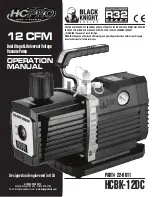
INSTALLATION AND ASSEMBLY WORK WARNINGS
While connecting electrical cables to the machin
e’s motor, take care of the mechanism
inside the connection box, check that no pieces of cable remain inside after closure and
that the earth contact is correctly connected. Connect the motor using the electrical
diagram attached to the machine.
Check tha
t the electrical cable connections to the machine’s terminal box are well set
and firmly attached to the connection terminals.
The pump electrical installation should have a differential the value of which is not
greater than 30mA.
Check that the terminal box joint is used correctly, thus preventing water from entering
the terminal box of the electric motor. Likewise, check that the packing gland has been
placed and pressed correctly inside the joint.
The pumps must always be fixed horizontally, especially models with pre-filter.
It is always advised to install them below water level, especially those that are not "self
priming" (centrifugal pumps). Models type "self-priming" can be installed above water
level, but the geometric height should not exceed 2 meters. Moreover, the suction pipe
should be as short as possible to reduce suction time. Also, make sure that the place
where the pump will be installed is always dry and airy.
Special attention should be paid to ensure that under no circumstances water gets into
the motor and the electric voltage parts.
Should the envisaged use not be different from that mentioned, adaptations and
supplementary technical regulations might be necessary.
STARTING-UP WARNINGS
Before starting the pump for the first time, verify the calibration of the motor electric
protection mechanisms and check that the protectors against electrical and mechanical
contacts are correctly positioned and well fixed.
It is recommended not to use the pool during that first check of the pumping equipment
installation.
ASSEMBLY AND MAINTENANCE WORK WARNINGS
National installation regulations should be taken into account when assembling and
installing the pumps.
Special attention should be paid to ensure that under no circumstances water gets into
the motor and the electric voltage parts.
Any contact, even accidental, with the machine’s moving parts should be avoided while
the machine is operating and/or before it completely stops.
Wait until the machine has completely stopped in order to carry out any work on it.
Before undertaking any electrical or mechanical maintenance make sure that the
machine has been disconnected from the supply network and starting-up mechanisms
are blocked.
Before working on the machine it is advisable to follow the steps below:
1. Cut the machine voltage.
2. Block the starting-up mechanisms.
3. Check that there is no voltage in the circuits, including the auxiliaries and
supplementary services.
4. Wait until the wheel has stopped completely.
HINWEISE ZU INSTALLATIONS- UND MONTAGEARBEITEN
Beachten Sie beim Anschluss der Elektrokabel an den Motor die richtige Anordnung im
Inneren des Anschlusskastens. Lassen Sie keine Kabelreste im Inneren zurück und
vergewissern Sie sich, dass die Erdleitung korrekt angeschlossen ist. Schliessen Sie
den Motor entsprechend dem der Pumpe beiliegenden Schaltplan an.
Kontrollieren Sie, dass die Elektrokabel richtig an den Anschlussklemmen des
Verbindungskastens der Maschine eingepasst und befestigt sind.
Die Pumpen müssen über eine Fehlerstrom-Schutzeinrichtung (RCD) mit einem
Bemessungsstrom von nicht mehr als 30mA versorgt werden.
Vergewissern Sie sich, dass die Dichtung des Anschlusskastens korrekt schließt und
kein Wasser in den Anschlusskasten des Elektromotors eindringen kann. Vergewissern
Sie sich auch, dass die Stopfbüchse im Inneren der Kabelführung des Anschlusskastens
angebracht und gut befestigt ist.
Die Pumpen müssen in horizontaler Lage befestigt werden, das gilt insbesondere für die
Modelle mit Vorfilter.
Es wird generell ein Einbau unterhalb des Wasserspiegels empfohlen, besonders bei
den „nicht selbstansaugenden“ Modellen (Kreiselpumpe). Selbstansaugende Modelle
können oberhalb des Wasserspiegels eingebaut werden, wobei aber die geometrische
Höhe nicht mehr als zwei Meter betragen darf. Andererseits muss die Saugleitung so
kurz wie möglich sein, um die Ansaugzeit zu verringern. Vergewissern Sie sich auch,
dass der Raum, in dem sich die Pumpe befindet, stets trocken und belüftet ist.
Der Motor und die stromführenden Geräteteile dürfen auf keinen Fall mit Wasser in
Berührung kommen.
Wenn das Gerät für einen anderen als den hier genannten Zweck verwendet werden
soll, können Anpassungen und zusätzliche technische Normen nötig werden.
HINWEISE ZUR INBETRIEBNAHME
Vor der ersten Inbetriebnahme des Geräts muss die Eichung der elektrischen
Schutzvorrichtungen des Motors geprüft werden und es muss sichergestellt sein, dass die
Abdeckungen zum Schutz vor mechanischem und elektrischem Kontakt richtig angebracht
und befestigt sind.
Es wird empfohlen, bei der ersten Betriebsprüfung der Pumpanlage das Bad nicht zu
benutzen.
HINWEISE ZU MONTAGE UND WARTUNG
Bei
der
Montage
und
Installation
der
Pumpen
sind
die
nationalen
Installationsvorschriften zu beachten.
Achten Sie strikt darauf, dass kein Wasser in den Motor und in stromführende
Geräteteile eindringen kann.
Vermeiden Sie während des Betriebsablaufs und solange die Maschine nicht völlig zum
Stillstand gekommen ist, jede, auch versehentliche, Berührung mit den beweglichen
Teilen der Maschine.
Warten Sie, bis die Maschine zum Stillstand gekommen ist, bevor Sie Arbeiten daran
ausführen.
Stellen Sie sicher, dass die Maschine vom Stromnetz getrennt ist und die
Anlaufvorrichtungen gesperrt sind, bevor Sie elektrische oder mechanische
Wartungsarbeiten durchführen.
Vor allen Arbeiten am Gerät beachten Sie bitte die folgenden Schritte:
1. Ziehen Sie den Netzstecker.
2. Sperren Sie die Anlaufvorrichtung.
3. Vergewissern Sie sich, dass weder im Stromkreis noch im Hilfsstromkreis oder



























